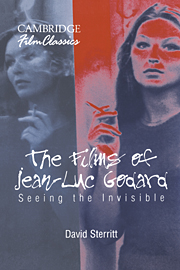6 - Hail Mary
Published online by Cambridge University Press: 12 January 2010
Summary
Chaos speaks precisely to the abyss or the open mouth, that which speaks as well as that which signifies hunger.
–Jacques Derrida, The Gift of DeathGodard and Mièville remained fascinated with video long after their mid- 1970s explorations of its unique possibilities, both on its own and in conjunction with film. Numèro deux and the other short features made around the same time, Here and Elsewhere and Comment ça va, were followed by two massive television series: Six fois deux/Sur et sous la communication, with six one-hundred-minute segments, and France / tour/ dètour / deux /enfants, with twelve segments of about thirty minutes each. Two major films, Sauve qui peut (la vie) and Passion, were accompanied by video essays called scènarios, brief ruminations on the films and some issues they raised for the artists. Additional video productions have rolled from Godard's camera ever since, most notably the Histoire(s) du cinèma series that became one of his major preoccupations starting in 1989.
Some critics responded to these video works as if they were mere sketches, divertissements, or minor adjuncts to movies that were the real achievements; others greeted the best of them (such as Scènario du film Passion, which some found equal to Passion itself) as creative triumphs in a medium that “serious” directors still tended to avoid. Godard's excursion into video proved intense and long-lasting enough to quell any doubts about the sincerity of his commitment; yet his deepest energies continued to gravitate toward feature filmmaking, and full-length film productions must dominate any list of his most thoughtfully received works.
- Type
- Chapter
- Information
- The Films of Jean-Luc GodardSeeing the Invisible, pp. 161 - 220Publisher: Cambridge University PressPrint publication year: 1999

